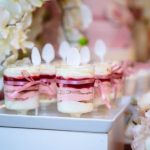What is gum paste for cake decorating? Gum paste is a versatile and essential ingredient in the world of cake decoration. In this article, we will explore the history, ingredients, tools, benefits, and techniques associated with gum paste in cake decorating. Whether you are a beginner or an experienced baker, understanding the role and function of gum paste can elevate your cake decorating skills to new heights.
Gum paste has a rich history that dates back centuries, and its evolution has led to numerous advancements in the art of cake decoration. From its origins to modern-day applications, the history of gum paste provides insight into its significance in the culinary world. Additionally, we will delve into the ingredients and recipe for making gum paste from scratch, offering step-by-step instructions for creating this essential element for cake decorating.
Furthermore, we will explore the essential tools and techniques required for working with gum paste to create stunning and structurally sound cake decorations. Understanding how to effectively use gum paste will expand your creative possibilities and enhance the aesthetic appeal of your cakes. Join us as we uncover the secrets behind successful gum paste cake decorations and learn valuable tips and tricks from expert decorators.
History of Gum Paste
The history of gum paste dates back to ancient Egypt, where it was used to create decorations for ceremonial cakes and pastries. Over time, the technique of using gum paste for cake decorating spread to other parts of the world, including Europe and Asia. In Europe, gum paste became popular during the Renaissance period, when elaborate cake decorations were in vogue among the nobility.
The modern version of gum paste as we know it today has its origins in England during the 16th century. It was initially used to create lifelike flowers and other intricate designs for royal banquets and special occasions. The development of various tools and techniques for working with gum paste also contributed to its evolution as a popular cake decorating method.
One key historical development in the use of gum paste for cake decorating occurred in the 20th century with the introduction of commercially-produced gum paste products by baking supply companies. This made it easier for home bakers and professional pastry chefs alike to access and use gum paste in their cake decorating projects.
| Year | Significance |
|---|---|
| Ancient Egypt | First recorded use of gum paste for cake decorations |
| 16th Century England | Gum paste used for creating lifelike flowers and intricate designs |
| 20th Century | Commercial production of gum paste products makes it more accessible |
Ingredients and Recipe
What Is Gum Paste for Cake Decorating?
Gum paste, also known as modeling paste, is a versatile and pliable sugar dough that is commonly used in cake decorating. It is different from fondant in that it dries harder and can be molded into intricate shapes and designs. Gum paste is an essential element for creating lifelike flowers, figurines, and other decorative elements that add an elegant touch to cakes.
Ingredients for Making Gum Paste
The key ingredients for making gum paste include confectioners’ sugar (powdered sugar), tylose powder (or CMC powder), gelatin, water, vegetable shortening, and glucose syrup. These ingredients are combined to create a smooth and elastic dough that can be rolled out thinly and shaped into various forms. The precise measurements and proper mixing of these ingredients are crucial to achieving the desired consistency and texture of the gum paste.
Recipe for Making Gum Paste
To make gum paste, the first step is to sift the confectioners’ sugar and tylose powder together in a large bowl. In a separate bowl, gelatin is bloomed in water, then dissolved over low heat. The gelatin mixture is then added to the sifted sugar along with vegetable shortening and glucose syrup.
The ingredients are mixed until a smooth dough forms. The gum paste is then kneaded until it becomes elastic and pliable. Once made, it can be tinted with food coloring or left white depending on the desired design for cake decorations.
Gum Paste Tools and Techniques
Gum paste is a versatile and essential component in the world of cake decorating. It provides artists and bakers with the ability to create intricate and stunning decorations that can elevate the overall look of a cake. In order to work with gum paste effectively, it is important to have the right tools and be familiar with various techniques.
One of the essential tools for working with gum paste is a rolling pin. This allows decorators to roll out the gum paste to their desired thickness before shaping or cutting it into various decorative elements. Additionally, having a sharp modeling tool is crucial for creating intricate details and textures on the gum paste.
Another important technique when working with gum paste is knowing how to properly color and tint it. Whether using gel or powdered food coloring, it’s important to knead the color into the gum paste evenly in order to achieve vibrant and consistent results.
Furthermore, understanding how to handle and store gum paste is key in cake decorating. Gum paste dries out quickly when exposed to air, so it’s important to keep it covered at all times when not in use. When working on intricate decorations, keeping small portions covered while focusing on one element at a time can be beneficial.
| Essential Tools | Important Techniques |
|---|---|
| Rolling pin | Coloring and tinting |
| Modeling tool | Handling and storing |
Benefits of Using Gum Paste
Gum paste is a versatile and indispensable tool in the world of cake decorating, offering a wide range of benefits that enhance both the visual appeal and structural integrity of cake decorations. From delicate flowers to intricate figurines, gum paste gives decorators the ability to create stunning and realistic designs that would be difficult or impossible to achieve with other techniques.
Enhanced Aesthetic Quality
One of the primary benefits of using gum paste in cake decorating is its ability to create incredibly lifelike and detailed decorations. Unlike fondant, which can be rolled out thinly but has limitations in terms of intricate details, gum paste can be rolled out even thinner and molded into highly realistic shapes.
This makes it an ideal medium for crafting delicate petals of flowers, ornate lace designs, and finely sculpted figurines. The pliability and quick-drying nature of gum paste also allow decorators to add intricate textures and patterns with ease, resulting in stunning visual effects on cakes.
Structural Integrity
In addition to its aesthetic benefits, gum paste also provides structural support for cake decorations. When properly dried, gum paste becomes firm and sturdy, making it an ideal choice for creating three-dimensional elements such as bows, ribbons, and standing figurines. Its ability to hold its shape makes it particularly useful for creating gravity-defying designs that simply wouldn’t be possible with softer mediums like buttercream or fondant alone.
Durability
Another key benefit of using gum paste is its durability once dried. Unlike some other decorative mediums that can droop or lose their shape over time, gum paste decorations maintain their form and solidity for extended periods.
This makes them an excellent choice for cakes that need to be displayed for long periods at events such as weddings or parties. Additionally, because they harden when exposed to air, gum paste decorations are less likely to be damaged during transport or while being handled on the cake.
In summary, the use of gum paste in cake decorating not only enhances the aesthetic quality of creations but also provides crucial structural support and durability. Its versatility allows decorators to create intricate designs that elevate cakes from ordinary confections to works of edible art. With these properties in mind, it’s no wonder why gum paste has become an essential tool for professional and amateur cake decorators alike.
Gum Paste vs Fondant
When it comes to cake decorating, there are various techniques that can be used to create stunning and intricate designs. Two of the most popular techniques are gum paste and fondant. While both can be used to create impressive decorations, they have distinct differences that make them suitable for different purposes.
Gum paste, which is also known as sugar paste, is a pliable and edible sugar dough that is frequently used in cake decorating. It is often made using a mixture of confectioner’s sugar, water, and tylose powder or gum tragacanth. Gum paste has a smooth texture and dries quickly, making it ideal for creating delicate flowers, figurines, and other intricate decorations that need to hold their shape.
On the other hand, fondant is a sweet icing that is rolled out and draped over cakes to create a smooth and polished finish. Unlike gum paste, which dries hard and firm, fondant remains soft and pliable even after it has been shaped or molded. Fondant is commonly used to cover entire cakes or create simple shapes and designs.
In terms of versatility, gum paste offers more flexibility for creating detailed decorations due to its ability to dry quickly and hold its shape once hardened. On the other hand, fondant is better suited for covering larger surface areas of cakes and creating smooth finishes. Understanding the differences between these two popular cake decorating techniques allows decorators to choose the most appropriate method based on their specific design needs.
Tips and Tricks for Working With Gum Paste
Gum paste is a versatile and essential ingredient in cake decorating, allowing for intricate and delicate designs that can elevate the aesthetic quality of any cake. However, working with gum paste can be challenging for beginners. Here are some expert tips and tricks to help you successfully use gum paste in your cake decorating projects:
Proper Storage
One of the most important aspects of working with gum paste is ensuring that it is stored properly to maintain its freshness and pliability. When not in use, wrap the gum paste tightly in plastic wrap and store it in an airtight container at room temperature. Avoid refrigerating or freezing gum paste, as it can cause condensation and make the paste too sticky to work with.
Kneading Technique
Proper kneading is crucial for achieving the right consistency of gum paste. To avoid air bubbles and ensure smooth texture, knead the gum paste on a clean surface using a small amount of vegetable shortening to prevent sticking. Use gentle pressure to avoid overworking the paste which can result in a dry and cracked appearance.
Precision Cutting
When creating shapes or designs with gum paste, use precision cutting tools such as sharp knives or craft scissors to achieve clean edges and intricate details. Dusting your tools with cornstarch or powdered sugar will prevent sticking and make it easier to cut through the gum paste without distorting its shape.
By following these expert tips and tricks, you’ll be able to work with gum paste more effectively, enhancing your cake decorating skills and creating stunning edible works of art. With patience, practice, and attention to detail, you can master the art of working with gum paste to take your cake decorations to the next level.
Inspiration and Ideas
When it comes to cake decorating, gum paste offers endless possibilities for creating beautiful and intricate designs. From delicate flowers to intricate figurines, gum paste allows decorators to bring their creative visions to life. Here are some creative examples of gum paste decorations that can elevate any cake design:
- Floral Bouquets: Gum paste is the perfect medium for crafting lifelike flowers that can be arranged into stunning bouquets. Whether it’s roses, peonies, or orchids, gum paste allows decorators to create intricate floral arrangements that add a touch of elegance to any cake.
- Novelty Toppers: From whimsical animals to miniature vehicles, gum paste can be shaped and molded into a variety of novelty toppers that add personality and charm to cakes. These unique decorations are perfect for themed parties and special occasions.
- Lace Details: Intricate lace patterns can be created using gum paste to add a touch of sophistication to wedding cakes and other elegant designs. Whether it’s delicate filigree or intricate lace appliques, gum paste provides the flexibility and durability needed for creating these fine details.
The versatility of gum paste allows decorators to explore their creativity and push the boundaries of traditional cake decorating. With the right tools and techniques, gum paste can be used to create custom designs that reflect the personality and style of any event or celebration.
Whether it’s a simple yet elegant floral arrangement or an elaborate sculpted figurine, gum paste offers limitless possibilities for bringing artistic flair to cake decorating. With patience, practice, and a bit of imagination, decorators can use gum paste as a versatile medium for transforming ordinary cakes into extraordinary works of art.
Conclusion
In conclusion, gum paste is a versatile and essential component in cake decorating. Its pliability and ability to hold intricate shapes make it a valuable tool for creating stunning and detailed cake decorations. Understanding the history, ingredients, tools, benefits, and techniques of working with gum paste is crucial for any cake decorator looking to elevate their creations to the next level.
The history of gum paste provides insight into its evolution as a cake decorating technique, highlighting its enduring popularity and effectiveness. Knowing the ingredients and recipe for making gum paste is essential for mastering this art form, as is understanding the tools and techniques necessary for working with it. The benefits of using gum paste are evident in the enhanced aesthetic appeal and structural quality it adds to cake decorations, allowing for more imaginative and intricate designs.
Frequently Asked Questions
Which Is Better Gum Paste or Fondant?
The choice between gum paste and fondant depends on the specific needs of the cake. Gum paste is ideal for creating intricate decorations that need to hold their shape, while fondant is better for covering cakes smoothly.
What Is Gum Paste on Cake?
Gum paste is a type of sugar dough that is used to create edible cake decorations such as flowers, leaves, and figurines. It dries hard and holds its shape well, making it perfect for intricate designs.
How Do You Stick Gum Paste to a Cake?
To stick gum paste to a cake, you can use a small amount of water or edible glue applied with a brush. Simply brush the area where you want to attach the gum paste decoration and gently press it into place. This method ensures that the decoration stays securely in place on the cake.

Welcome to my blog about home and family. This blog is a place where I will share my thoughts, ideas, and experiences related to these important topics. I am a stay-at-home mom with two young children. I hope you enjoy reading it! and may find some helpful tips and ideas that will make your home and family life even better!





